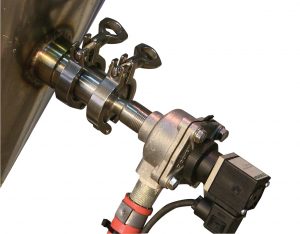USDA-Accepted AirSweep: The “Cleaner” Flow Aid
Comments Off on USDA-Accepted AirSweep: The “Cleaner” Flow Aid
Several industries need to use sanitary processes to comply with safety standards. This includes food and beverage, biotech and pharmaceutical, personal care, and cosmetics.
The USDA and FDA requires these industries to use hygienically designed equipment. According to Industrial Maintenance & Plant Operations (IMPO) magazine, this means they are:
- Cleanable and hygienically compatible with other plant systems
- Made of materials compatible with cleaning solutions
- Accessible for maintenance, cleaning, and inspection
- Free of recesses, corrosion, or areas that could collect product or liquid
- Able to facilitate validation and other sanitary protocols
Best flow aid for sanitary processes
The USDA- Accepted AirSweep is a powerful material flow aid especially designed for sanitary applications. It releases powerful air pulses that break material blocks, bridging, and ratholing. The unique sweeping action can even result in the vessel being flushed completely clean. Watch how it works:
Prevents spoilage and cross-contamination
Since AirSweep prevents stagnant material, plants avoid two of the biggest problems of sanitary manufacturing: spoilage and cross-contamination.
In fact, one of the world’s largest infant formula manufacturers uses the AirSweep USDA 135 and Straight Shooter models to break material blocks during production, and then clean the vessels between batch runs of regular and lactose-free formulas.
Works on all materials
The powerful air pulses can work on any material, including the sticky liquids or hygroscopic powders that are often used to make food, beverages, medicines, and cosmetics.
Many AirSweep customers used other flow aids like vibrators, fluidizers, and bin aerators, but still had to hammer the vessel to clear out material blocks. A US chocolate manufacturer said workers who scraped the vessel often bathed in big spills of cocoa powder. “They looked like giant cocoa puffs.”
AirSweep solved the problem. “It has a stronger air pulse than the bin aerators or fluidizers we previously installed. The air moves the powder down in a very large column so powder doesn’t stick to the walls,” said the coatings manager, Bob Wieland.
Airtight, minimal contact design
Only the nozzle tip has direct contact with the material. For each pulse, it opens for just 1/8” for ¼ seconds before snapping shut—for zero material feedback. The airtight design also guards against material retention and bacterial growth.
Easy to remove and clean
The AirSweep USDA-accepted models have flanged connections for quick installation or removal from mounting. It can be removed and disassembled with simple hand tools.
Can be used with corrosive cleaning materials
The stainless steel finish does not corrode or rust and can be safely cleaned with even the most potent disinfectants and chemicals.
Solve material blocks and meet safety standards. Contact us to find out more about AirSweep USDA-accepted models.
AirSweep Material Activation: More Powerful Than a Dozen Fluidizers – and Here’s Why
Comments Off on AirSweep Material Activation: More Powerful Than a Dozen Fluidizers – and Here’s Why
An aviation company that deices planes and runways uses pellets that are made of salt, binder, and other additives. Unfortunately, these materials are hygroscopic and have a tendency to clump and harden. The maintenance supervisor considered many different flow aids, but once he saw its description of “gentle vibration” he knew it wouldn’t work. “We needed something more…violent,” he said. He needed AirSweep.
When he saw an AirSweep video, he knew it was the solution they were looking for. The powerful air pulses could cut through moist and sticky materials like liquid cheese, heavy solids like gravel, and hygroscopic powders like cornstarch and titanium dioxide.
AirSweep Material Activation – More material moved per pulse
One AirSweep unit can activate more material than a dozen fluidizers. You can see this for yourself in this video that compares the two flow aids’ activation radius:
The smallest AirSweep, or model VA-06, activates a 1 to 2 foot radius, or about 300 to 600 millimeters. The AirSweep VA-12 activates a radius of about 3 to 4 feet, about 0.9 to 1.2 meters. The AirSweep VA-51 puts out a little more volume, so it activates a radius of up to 4 feet, or 1.2 meters, often even with denser products.
The role of pressure and volume
AirSweep harnesses air pressure and volume so each pulse can break material blocks and sweep them back into the flow stream. That’s why the system needs to have large pipes, headers, and receivers to run effectively.
Paul the AirSweep guy explains how this works, using the analogy of a garden hose and a fire hose.
AirSweeep is Powerful but energy efficient
Though AirSweep pulses require more plant CFM, it actually uses less energy and plant air than other flow aids.
AirSweep units are pulsed and run in a sequence, so even if you have 10 units on a vessel, they only pulse one at a time. It is more efficient than vibrators or fluidizers, which run continuously.
The AirSweep also uses less energy than air cannons and actually activates more material. One of the world’s largest cement companies had issues with clinker sticking to vessels and chutes. They tried using two AIRCHOC air cannons, but workers still had to use a bar to break the material.
AirSweep was an effective, fast, and simple solution. They were able to install it themselves in less than a day, and they never had to worry about clinker again. They even ordered 13 additional units for their various factories. “AirSweep works perfectly.”
Contact us to find out more about the AirSweep system, and how to set up one in your plant.
3 Safety Hazards Caused by Bridging, Ratholing, and Poor Material Flow
Comments Off on 3 Safety Hazards Caused by Bridging, Ratholing, and Poor Material Flow
Poor material flow doesn’t just affect productivity. It may lead to injury and hazardous plant environments, and compromise product safety.
Using an efficient flow aid, like AirSweep, can help protect the safety of your workers and your customers, and ensures that your company complies with industry regulations.
Fire hazards
A cheese company uses whey protein concentrate (WPC), which contains high moisture and fat and is prone to bridging over the discharge outlets. They had fluidizers and vibrators, but these still left a lot of caked material in the vessel.
Then one day, the caked material sparked a fire in one of their baghouses. Whey protein is classified as a combustible powder, and high concentrations can create a flammable environment.
While the fire was contained, bridging had become an urgent safety concern. They installed AirSweep, which cut through the sticky material and swept vessels completely clean. It now uses AirSweep in all its factories in the United States—to improve productivity and plant safety.
Many materials used in the food industry are classified as combustible: egg whites, powdered milk, cornstarch, sugar, flour, grain, potato, rice, etc. According to the Canadian Centre for Occupational Health and Safety, “The build-up of even a very small amount of dust can cause serious damage.”
The AirSweep USDA-accepted model can prevent material build-up and meets the sanitary requirements of the food industry.
Worker injury
Many plants resort to manual cleaning to clear stubborn material blocks. Workers have to hammer the vessel walls or climb into them to break up the blocks.
This process is tedious and exposes workers to several possible risks. Many powders and bulk solids can cause skin irritations or respiratory problems if they are directly handled or inhaled. Hammering and climbing into vessels can lead to falls and shoulder and back injuries.
Worker safety laws require companies to prevent worker injury and avoid giving tasks that the worker has not specifically been trained to do. The Occupational Safety and Health Administration (OSHA) standards include:
- Prevent exposure to harmful levels of substances
- Prevent exposure to loud noises that can damage hearing
- Ensure the safety of workers climbing into enclosures such as bins
- OSHA fines can reach up to $14,502 per violation. So, manual cleaning is neither an easy nor a cheap solution for material blocks.
Product spoilage and contamination
Ideally, materials in a vessel will have a first in/first out flow. This prevents spoilage and protects batch uniformity—and in some industries, like food and pharmaceuticals, this is critical for the consumer’s safety. Even cement can be unstable if the batch deviates from the correct proportions of materials.
AirSweep is used in those industries to achieve on-demand, first in/first out flow:
AirSweep can help you improve productivity and safety. Contact us to find out more about how AirSweep works, or ask for a customized proposal.
The Cost and Efficiency of Using Pressurized Air to Break Material Blocks
Comments Off on The Cost and Efficiency of Using Pressurized Air to Break Material Blocks
Pneumatic flow aids use pressurized air to stimulate material flow. Fluidizers and air pads use a combination of aeration and gentle vibration and are typically used for fine powders. However, low-pressure air can’t activate heavy materials or break bridging, arching, and ratholing.
AirSweep releases high-pressure air pulses and is proven effective for problematic materials. One unit can activate more material than dozens of fluidizers, and flush the vessel completely clean.
The AirSweep system just needs to be hooked up to a good air supply that provides enough pressure and volume to power up each pulse. Here are some frequently asked questions about AirSweep and the cost and efficiency of using pressurized air to solve material blocks.
Why do I need high-pressure air to solve material blocks?
Bridging, arching, and ratholing are caused either by a material’s high cohesive strength, or particles that interlock and are then further packed together by downward pressure.
The high-pressure air pulses create a shockwave that breaks up the material blocks and sweep up the stalled material out of the vessel. This can’t be achieved by gentle aeration.
How does AirSweep compare to air cannons and air knockers?
Air cannons and air knockers also use high-pressure air in higher volumes. However, these require more plant air and energy, and the strong recoil can cause metal fatigue.
Furthermore, using bigger blasts of air doesn’t necessarily improve material flow. The peak force lasts only 1/1000th of a second – subsequent discharge is wasted energy. The air also tends to “channel” through holes in the material, greatly diminishing effectiveness.
AirSweep releases short, controlled pulses exactly where and when you need it, so you never use more plant air or energy than you have to. You can control the position of each nozzle, the duration between each pulse, and the sequence. You can also choose between the classic AirSweep which releases pulses in 360 degrees or the Straight Shooter model which releases a vertical column of air.
What kind of plant air can be used?
The AirSweep can pass any inert medium that can be pressurized. Some plants have even used nitrogen with AirSweep to help purge oxygen from the vessel to reduce explosion or fire hazards.
Is it expensive to use high-pressure compressed air?
AirSweep is very cost-efficient. Unlike fluidizers and air pads which run continuously, the nozzles release air pulses in sequence. So even if you have several units on a vessel, they only pulse one at a time. AirSweep also uses less plant air and electricity than air cannons and air knockers.
Can damp air damage the AirSweep?
Damp air will not damage the unit itself, but it can introduce moisture into the material and cause it to cake or gum up. That is why we recommend treating the air before it goes into the system.
Can AirSweep cause air pressure build-up?
Pressure build-up is not an issue because the AirSweep system is not run until the vessel is actively discharging.
The AirSweep design also allows you to customize the flow. For example, if the material has a tendency to overflow, air pressure can be lowered to lessen the volume or area of influence, or the pulse frequency and sequence can be changed. You can also get a smaller AirSweep unit with a smaller sweep diameter.
Will the air pulses cause segregation and demixing?
As long as the AirSweep is tied into the discharge cycle, there will be no segregation. In fact, AirSweep is often used to maintain blend uniformity.
An infant formula company uses AirSweep at the start of the packaging lines—where base powders with vitamins and other compounds are mixed—down to their receiving hoppers and sifters. The air pulses ensure continuous material flow, so the product remains consistent from start to finish.
Can AirSweep units on different vessels share systems like an air receiver?
If two vessels are used simultaneously, it depends on whether the compressed air supply can handle the load. If these are used simultaneously and are in close proximity, then they can be connected to the same air receiver, filter, and regulator.
Do you have questions about AirSweep and pneumatic flow aids that weren’t covered by this article? Contact us and we’ll be happy to give you information or customize a proposal.




